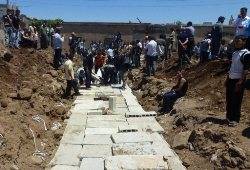The village of Taldou, near the town of Houla in Syria's Homs province was the scene of one of the worst massacres in the country's 14-month-long uprising.
United Nations observers on the ground have confirmed that at least 108 people were killed, including 49 children and 34 women. Some were killed by shell fire, but the majority appear to have been shot or stabbed at close range.
But at whose hands they died remains a matter of contention. Anti-government activists, eyewitnesses and human rights groups - including the UN's high commissioner for human rights - point the finger at the Syrian army and the shabiha, a sectarian civilian militia that supports the regime of Bashar al-Assad.
The United Nations has condemned the "indiscriminate and disproportionate use of force", but Maj Gen Robert Mood, the head of the UN Supervision Mission in Syria, said "the circumstances that led to these tragic killings are still unclear".
Protest attacked
The picture being pieced together by activists, survivors and the limited number of international journalists and human rights organizations in Syria is of an attack that began with the army shelling the town and ended with regime’s militiamen killing people house-by-house late into the night.
Rupert Colville, spokesman for the UN High Commissioner for Human Rights, has said initial investigations suggest the majority of the victims were "summarily executed in two separate incidents" while fewer than 20 were killed by artillery or shell fire.
Eyewitnesses say that at about 13:00 local time (10:00 GMT) on Friday, just after midday prayers, soldiers fired on a protest in Taldou in the Houla area to disperse the crowds.
Some accounts report that opposition fighters then attacked the Syrian army position where the firing was coming from.
Activists and eyewitnesses say the Syrian army shelled the town, reportedly at first with tank fire then with mortars, in a sustained bombardment that lasted at least two hours.
This tallies with UN accounts of tank and mortar shells in civilian areas. The UN Security Council issued a statement saying that "such outrageous use of force against civilian population constitutes a violation of applicable international law".
According to activists and eyewitnesses interviewed by the BBC, other media and human rights groups, army shelling paved the way for a concerted ground attack by the Alawite-dominated pro-government militia, the shabiha.
Their reports suggest that men from the shabiha entered people's houses in army fatigues and either cut their throats or shot them in the head from approximately 16:00 to 01:00 on Saturday morning.
One opposition activist from the area, Hamza Omar, told the BBC: "The shabiha militias attacked the houses. They had no mercy. We took pictures of children, under 10 years [old] their hands tied, and shot at close range."
If that is the case, it is possible the killers were drawn from a string of largely Alawite villages to the south of Houla region. Fearing reprisals, some residents there have apparently been donating blood to help the approximately 300 injured.
Many of the dead come from the extended Abdul Razak family, which has a cluster of houses near to each other in the village.
In an interview with Human Rights Watch, an elderly woman from the family recounted: "I was in the house with my three grandsons, three granddaughters, sister-in-law, daughter, daughter in-law and cousin.
"At about 18:30 we heard gunshots. I was in a room by myself when I heard the sound of a man. He was shouting and yelling at my family. I hid behind the door... They were wearing military clothes.
"After three minutes, I heard all my family members screaming and yelling... As I approached the door, I heard several gunshots. I heard the soldiers leaving. I looked outside the room and saw all of my family members shot."
'Heroic Syrian army'
These eyewitness accounts are by video evidence and have also been confirmed by the Syrian government, although they blamed “terrorists” for the attacks.
"Women, children and old men were shot dead. This is not the hallmark of the heroic Syrian army," foreign ministry spokesperson Jihad Makdissi told reporters in Damascus.
At a news conference in Moscow with his British counterpart William Hague, Russian foreign minister Sergei Lavrov said “it was clear the army had used tank shells but not who shot civilians at point blank range.”
Alexei Pushkov, chair of the international affairs committee of the Russian parliament, the Duma, was more explicit: "We have very strong doubts that those people who were shot at point-blank [range] and were stabbed, that this was the action of forces loyal to President Assad," he told the BBC.
"The shelling was probably the responsibility of the troops of Assad, but the stabbing and point-blank firing was definitely from the other side."
The UN's Maj Gen Mood told the BBC that monitors are continuing their investigations in Taldou to try and uncover the truth about what the Security Council has called an "appalling and brutal crime".
PHOTO CAPTION
People watch the May 26 mass burial of more than 100 victims of the Houla massacre in Syria.
Source: BBC


 Home
Home Discover Islam
Discover Islam Quran Recitations
Quran Recitations Lectures
Lectures
 Fatwa
Fatwa Articles
Articles Fiqh
Fiqh E-Books
E-Books Boys & Girls
Boys & Girls  Articles
Articles










